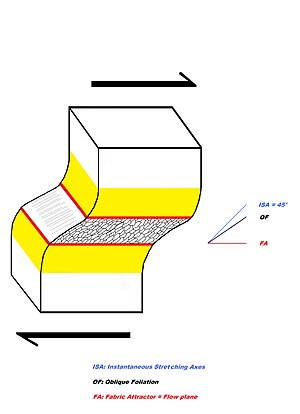
Structural geology is the study of the three-dimensional distribution of rock units with respect to their deformational histories. The primary goal of structural geology is to use measurements of present-day rock geometries to uncover information about the history of deformation (strain) in the rocks, and ultimately, to understand the stress field that resulted in the observed strain and geometries. This understanding of the dynamics of the stress field can be linked to important events in the geologic past; a common goal is to understand the structural evolution of a particular area with respect to regionally widespread patterns of rock deformation due to plate tectonics.
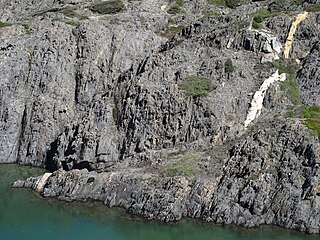
In geology, a shear zone is a thin zone within the Earth's crust or upper mantle that has been strongly deformed, due to the walls of rock on either side of the zone slipping past each other. In the upper crust, where rock is brittle, the shear zone takes the form of a fracture called a fault. In the lower crust and mantle, the extreme conditions of pressure and temperature make the rock ductile. That is, the rock is capable of slowly deforming without fracture, like hot metal being worked by a blacksmith. Here the shear zone is a wider zone, in which the ductile rock has slowly flowed to accommodate the relative motion of the rock walls on either side.

Mylonite is a fine-grained, compact metamorphic rock produced by dynamic recrystallization of the constituent minerals resulting in a reduction of the grain size of the rock. Mylonites can have many different mineralogical compositions; it is a classification based on the textural appearance of the rock.

The Narryer Gneiss Terrane is a geological complex in Western Australia that is composed of a tectonically interleaved and polydeformed mixture of granite, mafic intrusions and metasedimentary rocks in excess of 3.3 billion years old, with the majority of the Narryer Gneiss Terrane in excess of 3.6 billion years old. The rocks have experienced multiple metamorphic events at amphibolite or granulite conditions, resulting in often complete destruction of original igneous or sedimentary (protolith) textures. Importantly, it contains the oldest known samples of the Earth's crust: samples of zircon from the Jack Hills portion of the Narryer Gneiss have been radiometrically dated at 4.4 billion years old, although the majority of zircon crystals are about 3.6-3.8 billion years old.

In geology, shear is the response of a rock to deformation usually by compressive stress and forms particular textures. Shear can be homogeneous or non-homogeneous, and may be pure shear or simple shear. Study of geological shear is related to the study of structural geology, rock microstructure or rock texture and fault mechanics.
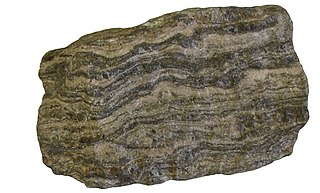
Foliation in geology refers to repetitive layering in metamorphic rocks. Each layer can be as thin as a sheet of paper, or over a meter in thickness. The word comes from the Latin folium, meaning "leaf", and refers to the sheet-like planar structure. It is caused by shearing forces, or differential pressure. The layers form parallel to the direction of the shear, or perpendicular to the direction of higher pressure. Nonfoliated metamorphic rocks are typically formed in the absence of significant differential pressure or shear. Foliation is common in rocks affected by the regional metamorphic compression typical of areas of mountain belt formation.
Lineations in structural geology are linear structural features within rocks. There are several types of lineations, intersection lineations, crenulation lineations, mineral lineations and stretching lineations being the most common. Lineation field measurements are recorded as map lines with a plunge angle and azimuth.

In geology, texture or rock microstructure refers to the relationship between the materials of which a rock is composed. The broadest textural classes are crystalline, fragmental, aphanitic, and glassy. The geometric aspects and relations amongst the component particles or crystals are referred to as the crystallographic texture or preferred orientation. Textures can be quantified in many ways. The most common parameter is the crystal size distribution. This creates the physical appearance or character of a rock, such as grain size, shape, arrangement, and other properties, at both the visible and microscopic scale.

A porphyroclast is a clast or mineral fragment in a metamorphic rock, surrounded by a groundmass of finer grained crystals. Porphyroclasts are fragments of the original rock before dynamic recrystallisation or cataclasis produced the groundmass. This means they are older than the groundmass. They were stronger pieces of the original rock, that could not as easily deform and were therefore not or hardly affected by recrystallisation. They may have been phenocrysts or porphyroblasts in the original rock.
In metallurgy, materials science and structural geology, subgrain rotation recrystallization is recognized as an important mechanism for dynamic recrystallisation. It involves the rotation of initially low-angle sub-grain boundaries until the mismatch between the crystal lattices across the boundary is sufficient for them to be regarded as grain boundaries. This mechanism has been recognized in many minerals and in metals.

Tectonites are metamorphic or tectonically deformed rocks whose fabric reflects the history of their deformation, or rocks with fabric that clearly displays coordinated geometric features that indicate continuous solid (ductile) flow during formation. Planar foliation results from a parallel orientation of platey mineral phases such as the phyllosilicates or graphite. Slender prismatic crystals such as amphibole produce a lineation in which these prisms or columnar crystals become aligned. Tectonites are rocks with minerals that have been affected by natural forces of the earth, which allowed their orientations to change. This usually includes recrystallization of minerals, and the foliation formation. Tectonites are studied through structural analysis and allows for the determination of two things:

Cataclasite is a cohesive granular fault rock. Comminution, also known as cataclasis, is an important process in forming cataclasites. They fall into the category of cataclastic rocks which are formed through faulting or fracturing in the upper crust. Cataclasites are distinguished from fault gouge, which is incohesive, and fault breccia, which contains coarser fragments.
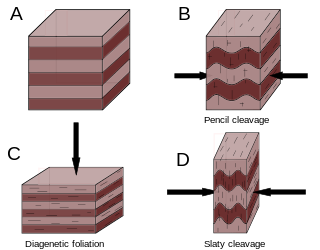
Cleavage, in structural geology and petrology, describes a type of planar rock feature that develops as a result of deformation and metamorphism. The degree of deformation and metamorphism along with rock type determines the kind of cleavage feature that develops. Generally, these structures are formed in fine grained rocks composed of minerals affected by pressure solution.
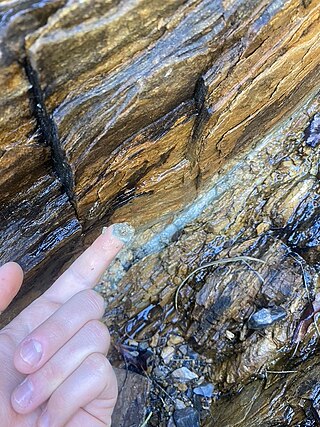
Fault gouge is a type of fault rock best defined by its grain size. It is found as incohesive fault rock, with less than 30% clasts >2mm in diameter. Fault gouge forms in near-surface fault zones with brittle deformation mechanisms. There are several properties of fault gouge that influence its strength including composition, water content, thickness, temperature, and the strain rate conditions of the fault.

In geology, a rock's fabric describes the spatial and geometric configuration of all the elements that make it up. In sedimentary rocks, the fabric developed depends on the depositional environment and can provide information on current directions at the time of deposition. In structural geology, fabrics may provide information on both the orientation and magnitude of the strains that have affected a particular piece of deformed rock.

Skolithos is a common trace fossil ichnogenus that is, or was originally, an approximately vertical cylindrical burrow. It is produced by a variety of organisms in shallow marine environments globally and appear as lineated features in sedimentary rocks.
The Piégut-Pluviers Granodiorite is situated at the northwestern edge of the Variscan Massif Central in France. Its cooling age has been determined as 325 ± 14 million years BP.
Strain partitioning is commonly referred to as a deformation process in which the total strain experienced on a rock, area, or region, is heterogeneously distributed in terms of the strain intensity and strain type. This process is observed on a range of scales spanning from the grain – crystal scale to the plate – lithospheric scale, and occurs in both the brittle and plastic deformation regimes. The manner and intensity by which strain is distributed are controlled by a number of factors listed below.
Paleostress inversion refers to the determination of paleostress history from evidence found in rocks, based on the principle that past tectonic stress should have left traces in the rocks. Such relationships have been discovered from field studies for years: qualitative and quantitative analyses of deformation structures are useful for understanding the distribution and transformation of paleostress fields controlled by sequential tectonic events. Deformation ranges from microscopic to regional scale, and from brittle to ductile behaviour, depending on the rheology of the rock, orientation and magnitude of the stress, etc. Therefore, detailed observations in outcrops, as well as in thin sections, are important in reconstructing the paleostress trajectories.

Julia Ann “Jan” Tullis is an American structural geologist and emerita Professor at Brown University. Tullis is known for her work in structural geology, especially for her experimental work in deformation mechanisms, microstructures, and rheology of crustal rocks.
